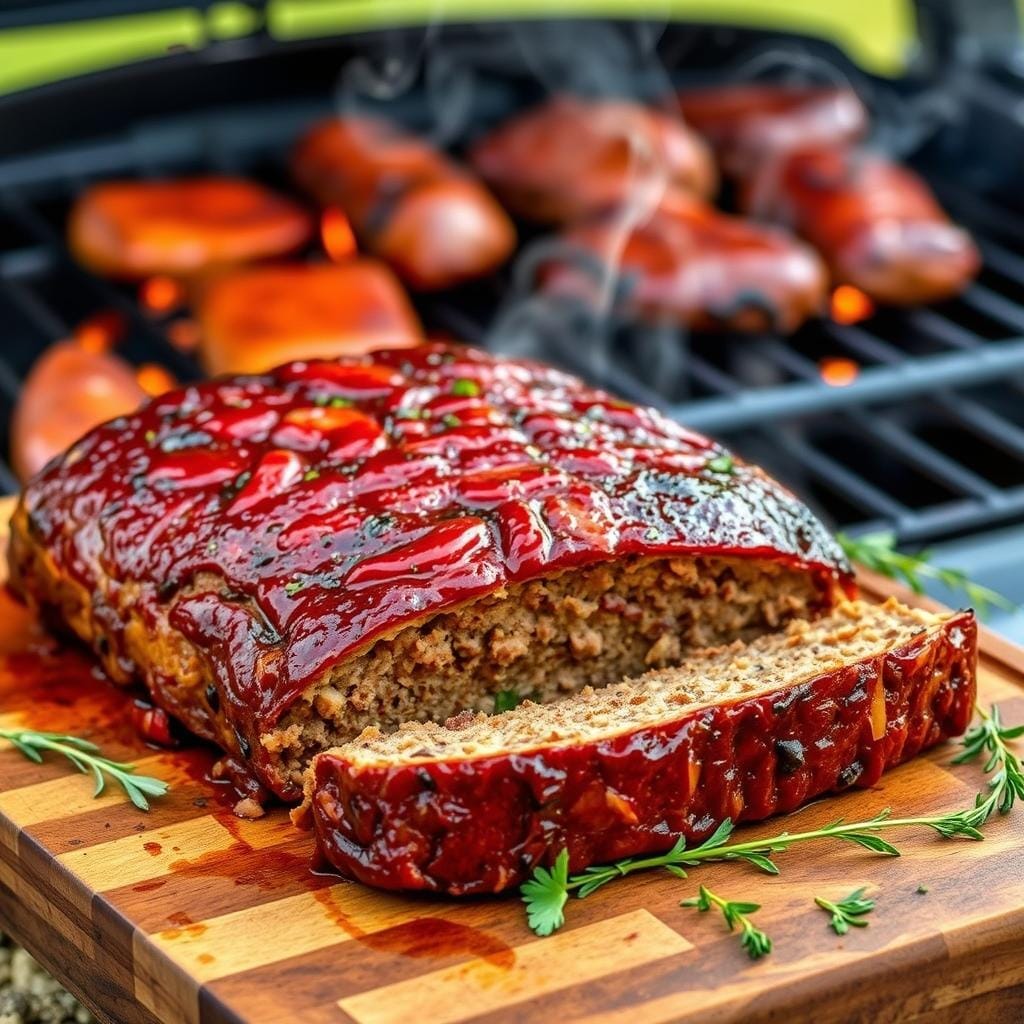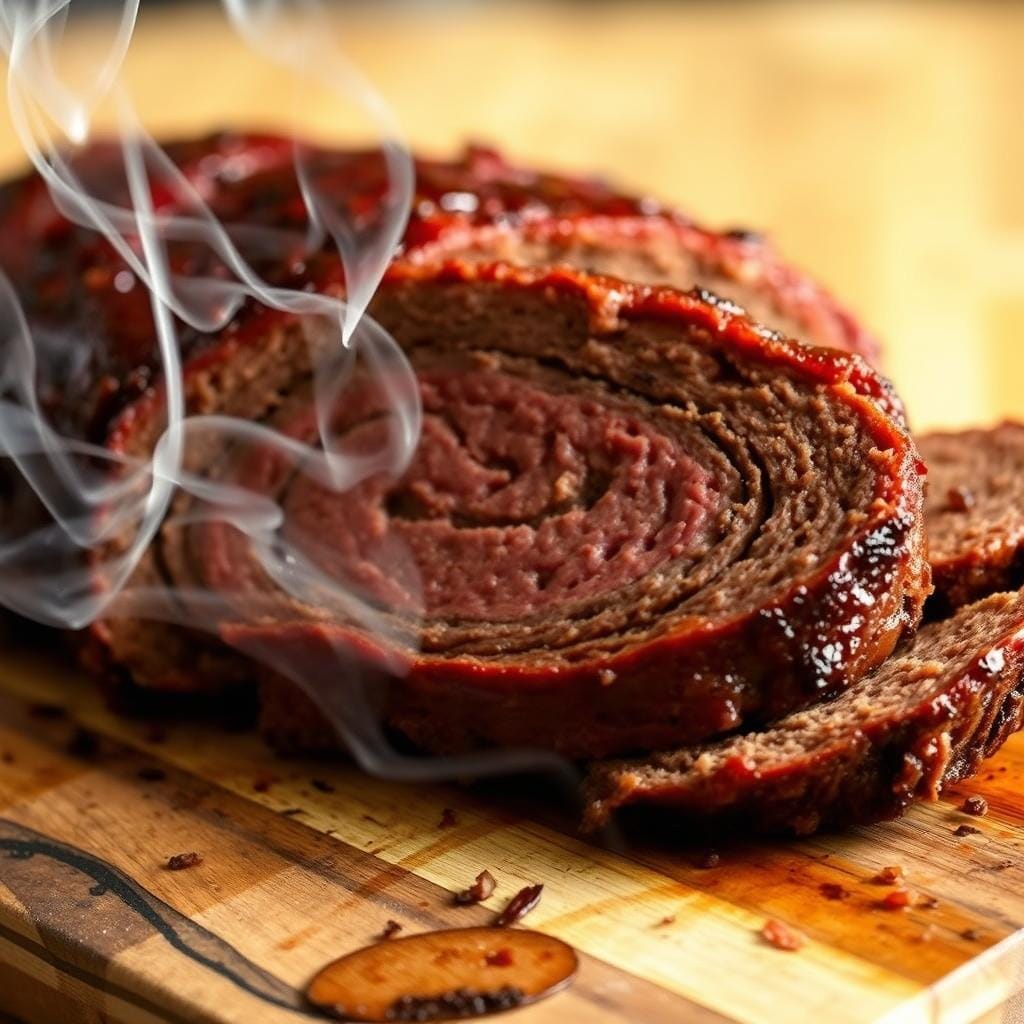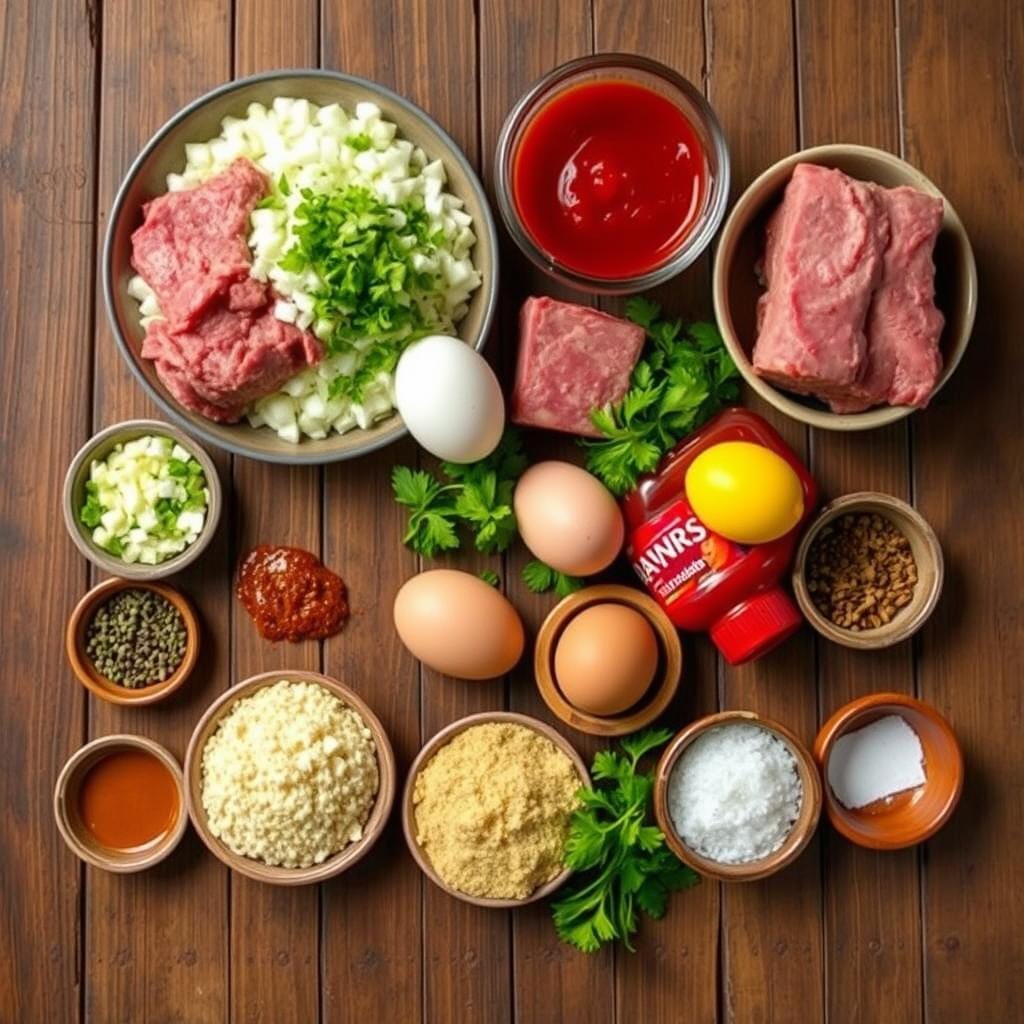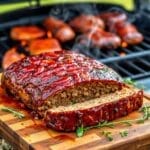If you’re searching for the best smoked meatloaf recipe, you’re in the right place. This dish takes a classic comfort food and transforms it with bold, smoky BBQ flavor that’s impossible to resist. Whether you’re hosting a backyard cookout or just craving something hearty and satisfying, this smoked meatloaf delivers juicy texture, rich taste, and unforgettable aroma.
In this guide, you’ll learn exactly how to make a tender, flavor-packed smoked meatloaf that everyone will love. From the perfect meat blend and seasoning tips to smoker setup and glazing techniques—we’ve got everything covered. Let’s fire up the smoker and turn your next meatloaf into a smoky masterpiece.

Key Takeaways
- Best meat mix: Combine ground beef and pork for the perfect texture and rich flavor.
- Secret to moisture: Use a panade (milk-soaked bread) to keep your meatloaf tender.
- Smoke low and slow: Maintain a smoker temp of 240°F and cook until internal temp hits 165°F.
- Glaze it right: Brush with BBQ sauce every 30 minutes for a flavorful, caramelized crust.
- Try variations: Go gourmet with cheese-stuffed or bacon-wrapped options.
Why Smoking Takes Meatloaf to the Next Level
Why Smoke Your Meatloaf?
Smoking brings out deep, bold flavors in meatloaf you can’t get from baking. A low and slow cook infuses it with smoky richness while keeping the texture soft and juicy. As it smokes, a pink smoke ring forms just beneath the crust—a badge of honor for BBQ lovers.
“Smoking meatloaf at a low temperature for an extended period is the secret to achieving a perfectly moist and flavorful result.”
Check out this Seafood Boil Sauce Recipe. Its bold flavors complement the smoky richness perfectly.

“Smoking meatloaf at a low temperature for an extended period is the secret to achieving a perfectly moist and flavorful result.”
Essential Ingredients for Smoked Meatloaf Recipe
Making a tasty smoked meatloaf needs the right mix of ingredients. At its core are the meatloaf ingredients, which include:
Meatloaf Base:
- 1 lb ground beef (80/20 preferred)
- 1 lb ground pork
- 2 eggs, beaten
- 1/2 cup milk
- 5 slices white or wheat bread (torn)
- 1/2 cup Italian panko breadcrumbs
- 1/2 cup diced onion
- 2 cloves garlic, minced
- 1 tsp seasoned salt
- 1/2 tsp black pepper
- 1 tsp garlic powder
- 2 tbsp Worcestershire sauce
For Glazing:
- 1/2 cup BBQ sauce (your favorite brand or homemade)
- Optional: honey, pepper jelly, or mustard for custom glazes

With this flavorful blend of ingredients, you’re ready to create the ultimate smoked meatloaf recipe. Each bite delivers juicy, smoky goodness that’s perfect for family dinners or weekend cookouts. This easy recipe brings together bold BBQ flavor and classic comfort, making it a guaranteed crowd-pleaser at your next gathering.
For an additional dish to round out your BBQ menu, try a side like Hellmann’s Potato Salad—a creamy and refreshing counterpoint to the smoky meatloaf.
The Perfect Meat Blend
Combining ground beef with pork enhances flavor and juiciness. The pork adds richness and helps prevent the meatloaf from drying out during smoking. Stick to an 80/20 fat ratio for the beef to ensure moisture.
The Secret to Moist Meatloaf: Making the Perfect Panade
The secret to ultra-moist meatloaf? A panade. Soak your bread slices in milk for about 5 minutes, then mash and fold into the meat mixture. This creates a juicy, tender bite every time.
Preparing Your Smoker for Meatloaf Success
To get the perfect smoked meatloaf, set your smoker to 240°F and choose your wood carefully. Hickory chips bring a bold, smoky flavor, while applewood adds a sweeter touch. If you’re looking for other dishes to experiment with in your smoker, these Dutch Oven Camping Recipes offer great inspiration for hearty meals.
Step-by-Step Smoked Meatloaf Recipe
Smoking your meatloaf takes it to a whole new level. It adds a delicious BBQ flavor. Follow this guide to make a juicy, perfectly-smoked meatloaf that will wow your guests.
- Prep the Panade: Soak torn bread in milk. Let it sit 5 minutes.
- Sauté Aromatics: Cook onion and garlic in a skillet until soft.
- Mix Ingredients: In a large bowl, combine meats, panade, panko, eggs, spices, Worcestershire, and sautéed veggies.
- Shape the Loaf: Form into a firm loaf on a wire rack or foil-lined pan.
- Smoke It: Place in smoker. After 30 minutes, start glazing every 30 minutes.
- Final Temp: Cook until internal temp reaches 165°F (2-4 hours depending on size).
- Rest: Let meatloaf rest 10-15 minutes before slicing.
The perfect blend of ground beef and pork, combined with a savory panade, creates a moist and flavorful smoked meatloaf. The low and slow cooking process in the smoker allows the smoke to penetrate the meat, while the BBQ glaze adds a delicious caramelized crust. Enjoy your perfectly smoked meatloaf with your loved ones!
BBQ Glazing Tips
- Apply glaze first after 30 minutes of smoke.
- Use a silicone brush for even coating.
- Reapply glaze every 30 minutes until done.
Bonus Glaze Ideas: Add a touch of bourbon or pepper jelly to your BBQ sauce for an extra zing.
Cooking Time & Temp Chart
Getting the timing and temperature right is essential for the perfect smoked meatloaf recipe. This quick reference chart ensures your meatloaf is juicy, safe to eat, and packed with smoky flavor every time.
| Stage | Temperature | Time |
|---|---|---|
| Smoker Preheat | 240°F | 15 min |
| Smoking Time | 240°F | 2-4 hours |
| Internal Temp | 165°F | N/A |
| Rest Time | N/A | 10-15 min |
Creative Variations
Cheese-Stuffed Meatloaf
- Add a layer of mozzarella or cheddar between two layers of meat.
- Seal edges to keep cheese from leaking.
Bacon-Wrapped Meatloaf
Helps retain moisture and adds a crispy exterior.
Wrap your formed loaf in a bacon weave.
FAQ About Smoking Meatloaf Recipe
What temperature do you smoke a meatloaf at?
To smoke a meatloaf well, heat your smoker to 240°F. This low temperature keeps the meatloaf juicy and full of flavor.
What is the secret to moist meatloaf?
The secret to moist meatloaf is a panade. It’s a mix of milk-soaked bread. This panade keeps the meatloaf moist and tender.
Does smoked meatloaf stall?
Yes, smoked meatloaf can stall like other smoked meats. Keep the temperature at 240°F and use a meat probe to check the meat’s internal temperature. This helps avoid drying out during the stall.
Why milk instead of water in meatloaf?
Using milk instead of water makes the meatloaf more tender and moist. The milk fat and proteins help the ingredients stick together. They also add richness to the dish.
What are the benefits of low and slow cooking for smoked meatloaf?
Cooking at 240°F prevents the meatloaf from drying out. It also gives a deeper smoky flavor. The slow cooking lets the smoke fully penetrate the meat, making it juicy and delicious.
How important is temperature control when smoking meatloaf?
Keeping the temperature steady is key for even cooking and keeping moisture in. Use a meat probe or wireless thermometer. This way, you can check the temperature without opening the smoker lid too often.
Additional Resources to Explore
Here are some excellent resources that delve deeper into smoking techniques and meatloaf preparation, perfect for enhancing your culinary skills:
- AmazingRibs.com – The Complete Guide to Meatloaf
- Meathead Goldwyn’s BBQ FAQ
- Serious Eats – How to Make the Best Meatloaf
Table of Contents

Smoked Meatloaf Recipe: The Ultimate BBQ Comfort Food
- Total Time: ~3.5 hours
- Yield: 6 servings 1x
Description
This smoked meatloaf recipe is a flavorful twist on a comfort food classic. Blended with beef and pork, infused with smoky wood chips, and finished with a sweet BBQ glaze—it’s tender, juicy, and perfect for backyard gatherings or cozy dinners.
Ingredients
- 1 lb ground beef (80/20)
- 1 lb ground pork
1 small yellow onion, finely chopped
2 cloves garlic, minced
2 eggs, beaten
1/2 cup milk
1 cup panko breadcrumbs (Italian style)
2 tbsp Worcestershire sauce
1 tsp seasoned salt
1 tsp garlic powder
1/2 tsp black pepper
1/2 cup BBQ sauce (for glazing)
Optional: bacon strips or mozzarella for stuffing
Instructions
- Sauté Aromatics: In a skillet, sauté chopped onion and minced garlic in a little oil for 5 minutes until soft and fragrant. Let cool.
- Make the Panade: In a bowl, soak breadcrumbs in milk for 5 minutes.
- Mix Meatloaf: In a large mixing bowl, combine ground beef, ground pork, eggs, Worcestershire sauce, seasonings, the soaked breadcrumb mixture, and sautéed aromatics. Gently mix until just combined.
Shape the Loaf: Form the meat into a loaf shape on a wire rack or foil-lined tray.
Prep the Smoker: Preheat smoker to 225–240°F. Add hickory or applewood chips for smoke flavor.
Smoke the Meatloaf: Place the meatloaf in the smoker and cook for 2–2.5 hours. Start glazing with BBQ sauce after 30 minutes and continue every 30 minutes.
Check Temperature: Use a meat thermometer to ensure the internal temp reaches 165°F.
Rest & Serve: Remove from smoker, rest for 15 minutes, slice, and serve with your favorite sides.
Notes
For extra flavor, stuff the center with shredded cheese or wrap the entire loaf in bacon before smoking.
The panade (milk-soaked breadcrumbs) is key to a moist smoked meatloaf.
Try different wood chips for unique smoke profiles.
- Prep Time: 20 minutes
- Rest TIme: 15 minutes
- Cook Time: 2.5–3 hours
- Cuisine: American BBQ
Nutrition
- Calories: 440
- Sugar: 4g
- Sodium: 650mg
- Fat: 29g
- Carbohydrates: 10g
- Protein: 36g

5 thoughts on “Smoked Meatloaf Recipe: The Ultimate BBQ Comfort Food”